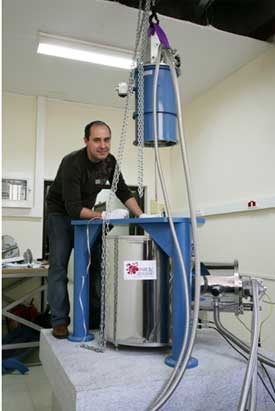Mar 20 2008
Physics research projects that involve ultra low temperatures have a major operational issue to address when competing against non-cryogenic proposals for research funding. This is ultimately due to the rising cost and increasingly unreliable supply of liquid helium, required for the cooling of conventional cryogenic equipment. However, there are now new technologies coming to the market that overcome this hurdle by offering the option of cryogen free measurement environments.

Systems based on closed cycle mechanical coolers have developed rapidly, providing the physics community with alternative means of reaching ultra low temperatures. Dr. Enrique Diez at Salamanca University, Spain has been trying out a radical new Cryofree® 3He refrigerator from Oxford Instruments, the special Heliox® ACV designed to fit with a Cryofree 12 T magnet.
Dr Diez commented, “Four years ago, when I started to set-up my laboratory devoted to magneto-transport in nanoelectronics devices; we concluded that technologies based on liquid helium were clearly not sustainable and we looked for new environmentally-friendly technologies that could provide ultra-low temperature and high-magnetic field environments without the use of liquid helium. We chose Oxford Instruments as the ideal partner and we developed a special Heliox ACV solution capable of working with a Cryofree magnet of 12 T with a room temperature open-bore of 55 mm.
In addition to the dramatic reduction of operating costs and the preservation of the natural resources of helium, there are many advantages compared to a regular 3He refrigerator. Operating this system is extremely simple, just pump out the vacuum space, press one button and wait. A very important advantage is that you can measure continuously from millikelvin to room temperature (without having to merge data measured in two cryostats) i.e. you do not need an additional system for studies in the range 10-300 K. On the other hand having the magnet outside your cryostat, provides the possibility of new experiments in biophysics and gives you much more flexibility if you do not need much sample space”